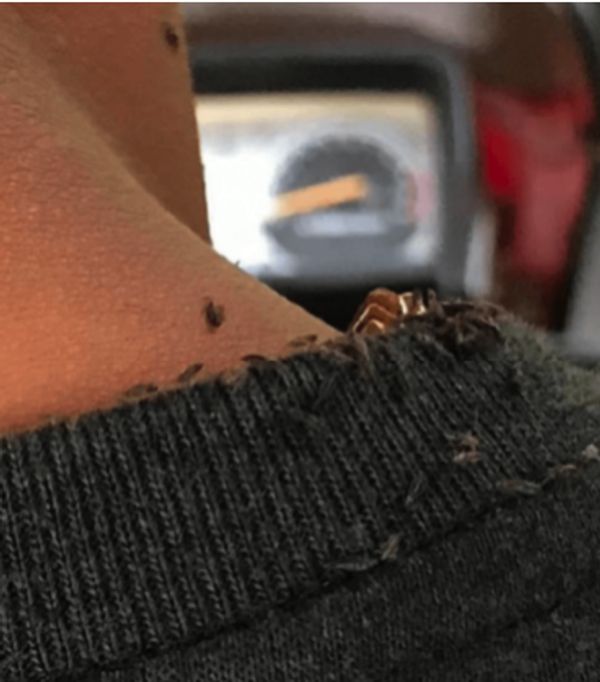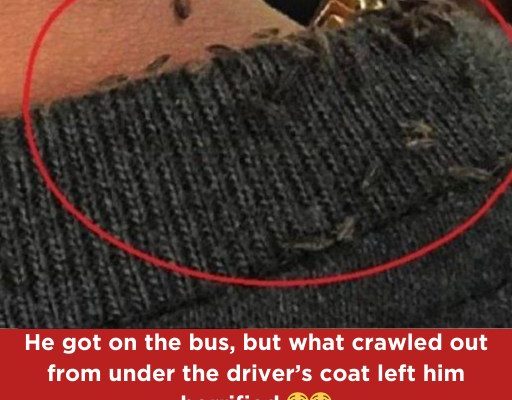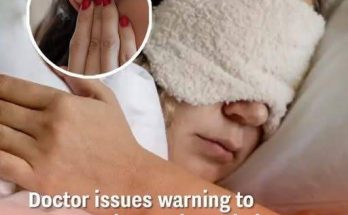In a shocking turn of events on a typical day, a bus full of passengers experienced a bizarre incident. While silently cruising along, one alert passenger noticed something strange on the driver’s coat. To his absolute disbelief, he discovered hundreds of insects crawling all over the driver’s neck and ears!

The passenger, named Primo Onipa, couldn’t believe his eyes. He quickly took out his phone and recorded the entire event. Filled with disgust and outrage, he shared the footage on Facebook, describing the insects as lice. He wanted to expose the situation and hold the bus driver accountable for his lack of hygiene.
According to Primo, the bus driver emitted an unpleasant odor and appeared to have not bathed or changed his clothes for more than a year. In the shocking photos, the driver seemed unfazed by the infestation, as if these little parasites had become a part of his daily life.
The video quickly gained attention on social media, causing a wave of outrage from internet users. Many expressed their concern that a man with lice should not be responsible for the safety and well-being of passengers on a bus.
But what exactly are lice? These microscopic insects live on the scalp and survive by feeding on blood. When they feast, they inject saliva into the skin, causing the irritating itch that we all dread.
Lice are about the size of sesame seeds and have a grayish-brown color. The female louse secretes a chemical to ensure the attachment of the eggs to the hair, typically at the base, around 3-4 millimeters from the scalp. They often reside behind the ears and in the neck area, where itching may initially be absent. However, scratching can lead to secondary infections.
Spotting lice can be incredibly challenging since they are tiny and agile. However, with some perseverance, they can be “caught” by covering the infested area with sticky tape. These pesky insects can have a devastating impact on a person’s self-esteem and self-image.
Contrary to popular belief, lice are not indicative of poverty or poor hygiene. They can affect anyone, regardless of cleanliness. The main concern is that they can spread various illnesses and are easily transmitted from person to person.
We can only imagine the horror and discomfort that both the passengers and the driver experienced during this incident. Unfortunately, the original video has been taken down, but let’s hope that the message reaches everyone. It serves as a reminder to prioritize personal hygiene and ensure a safe and clean environment for all.
Imagine stepping onto a bus, expecting a regular ride, only to discover it’s been taken over by a swarm of creepy crawlies! Here’s how such an unsettling event might unfold:
The Scenario
- Unexpected Guests: Passengers begin to notice small insects scuttling along the seats, walls, and floor of the bus. At first, it’s just a few, but soon, entire colonies are visible.
- Different Insects: The infestation might include ants, cockroaches, spiders, or even stinging insects like wasps or hornets.
- Chaotic Reaction: Screams erupt as people jump out of their seats, swatting at the bugs and rushing to get off the bus.
Possible Causes
- Leftover Food: Someone may have left food or drinks behind, attracting pests like ants or cockroaches.
- Unreported Nest: A colony of insects could have built a nest within the bus’s upholstery or vents.
- Unclean Maintenance: Poor cleaning and maintenance routines create the perfect breeding ground for insects.
- Passengers’ Belongings: A bag or luggage containing insects might have been brought onboard unknowingly.
Health Risks
- Bites and Stings: Some insects can bite or sting, potentially causing allergic reactions in sensitive individuals.
- Disease Transmission: Pests like cockroaches can spread harmful bacteria, leading to food poisoning or infections.
- Anxiety: Such an incident can leave passengers traumatized and wary of public transport.
How to Handle It
- Immediate Action: Notify the driver and request the bus be stopped safely for evacuation.
- Report the Incident: Alert the bus company or transit authority to investigate and address the problem.
- Professional Pest Control: The bus should undergo a thorough cleaning and pest control treatment.
- Preventive Measures:
- Regular cleaning and maintenance.
- Encouraging passengers to avoid eating or leaving trash behind.
Tips for Passengers
- Avoid placing bags on the floor or under seats.
- Inspect your belongings after encountering an infestation to prevent carrying pests home.
- If bitten or stung, monitor for allergic reactions and seek medical attention if necessary.
This kind of infestation is a nightmare for passengers and a PR disaster for transportation companies. Let’s hope it’s something none of us ever have to experience! 😨🪳



